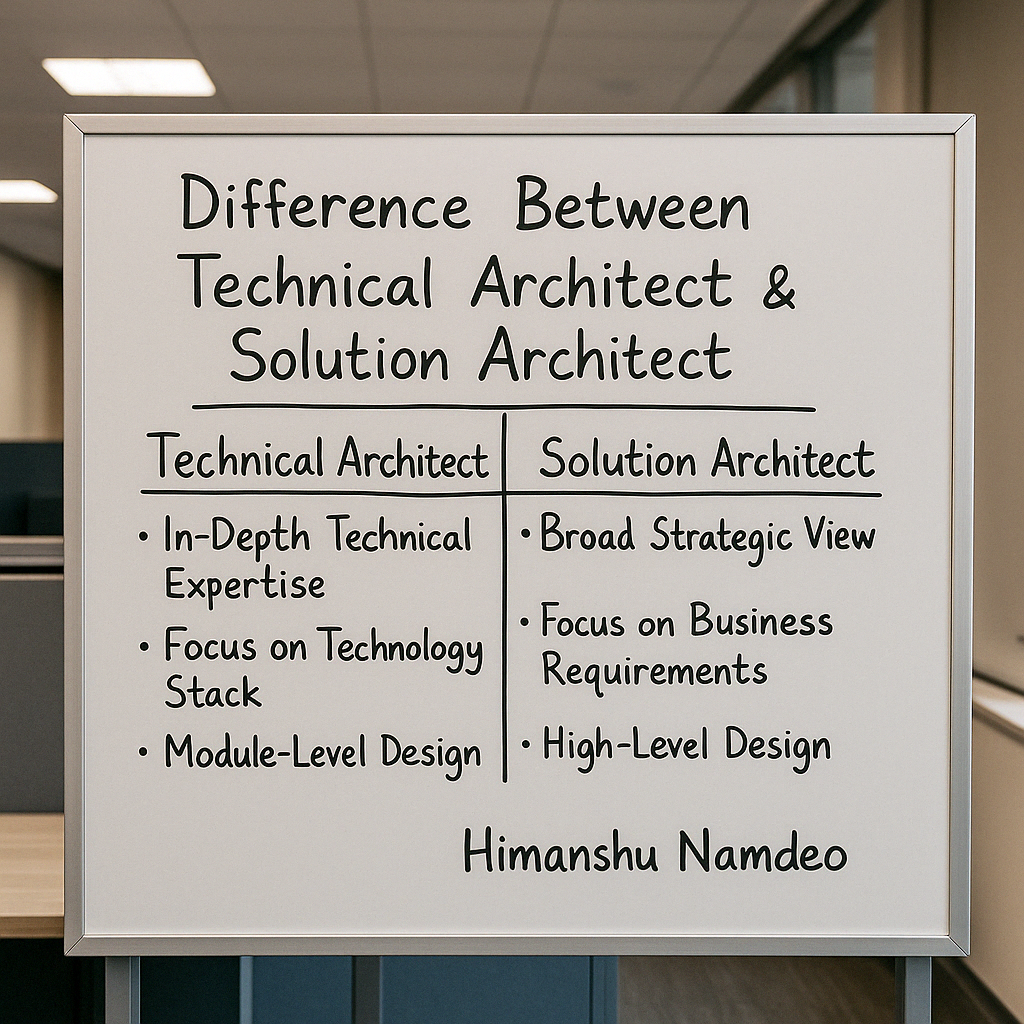In the ever-evolving tech world, two roles often get mentioned interchangeably but serve very different purposes—Technical Architect and Solutions Architect. Whether you’re planning your next career move or simply curious about architecture roles in IT, this post breaks it all down for you.
Key Differences Between Technical Architect and Solutions Architect
| Criteria | Technical Architect | Solutions Architect |
|---|---|---|
| Focus Area | Technology implementation | Business + Technology alignment |
| Main Responsibility | Define technical standards, code architecture | Design end-to-end solution for business needs |
| Scope | Narrow (specific tech stack or system) | Broad (cross-system or enterprise level) |
| Involvement | Deep dive into code, system architecture | Understand business goals, choose tech accordingly |
| Stakeholder Interaction | Mostly dev team & engineers | Business stakeholders, clients, product owners |
| Decision Making | Which technology, pattern, framework to use | Which solution, integration, and platform fits best |
| Documentation | Low-level design documents, tech diagrams | High-level architecture diagrams, proposals |
| Example Design Artifacts | Sequence Diagrams, Class Diagrams, Deployment Architecture | Solution Blueprint, Integration Flows, Service Catalogs |
Real-Time Example
Scenario: An EdTech company is building a Learning Management System (LMS).
- Solutions Architect: Defines what features are needed, whether to host on AWS or Azure, how to handle SSO, and ensures the platform supports multi-tenancy across clients.
- Technical Architect: Decides whether to use .NET Core or Node.js, designs the microservices structure, chooses Redis for caching, and builds the CI/CD pipeline.
What Should You Choose?
| Scenario | Role Fit |
|---|---|
| Love solving technical challenges & diving deep into code | 🧠 Technical Architect |
| Enjoy big-picture thinking & stakeholder communication | 🧩 Solutions Architect |
| Want to focus on performance, security, system design | ⚙️ Technical Architect |
| Want to influence business decisions & tech alignment | 🌐 Solutions Architect |
Salary Comparison (India & US)
| Role | India (INR/year) | US (USD/year) |
|---|---|---|
| Technical Architect | ₹25–40 LPA | $110k–$150k |
| Solutions Architect | ₹30–60 LPA | $130k–$180k |
Note: Salaries vary based on industry, experience, certifications, and company size.
Future Scope
- Technical Architect: Can grow into roles like Principal Engineer, CTO, or Product Architect.
- Solutions Architect: Can transition to Enterprise Architect, CTO, Digital Transformation Lead, or Technology Strategist.
📚 Recommended Courses and Certifications
For Technical Architect:
- Microsoft Certified: Azure Solutions Architect Expert
- AWS Certified DevOps Engineer
- Certified Kubernetes Administrator (CKA)
- Clean Code, SOLID Principles – Pluralsight/Udemy
For Solutions Architect:
- TOGAF® Certification (Level 1 & 2)
- AWS Certified Solutions Architect – Professional
- Google Cloud Architect Certification
- Business Strategy & Architecture Foundations – LinkedIn Learning
🧠 Mindset Shift for Each Role
| Role | Required Mindset |
|---|---|
| Technical Architect | System performance, scalability, code quality, mentoring devs, best practices |
| Solutions Architect | Client empathy, business alignment, integration focus, ROI-driven thinking |
💡 Final Thoughts: How to Choose Your Path?
Choosing between Technical Architect and Solutions Architect isn’t just about skill—it’s about interest, mindset, and long-term goals.
✅ If you enjoy solving code-level challenges, scaling systems, and guiding dev teams—go Technical.
✅ If you like connecting business goals with tech solutions, handling client discussions, and strategizing—go Solutions.
Both are rewarding roles, and many professionals evolve from Technical to Solutions with experience.
Let’s build your architecture journey together. 🔧🧠🌐
Have questions? Drop them in the comments below or reach out on LinkedIn.


